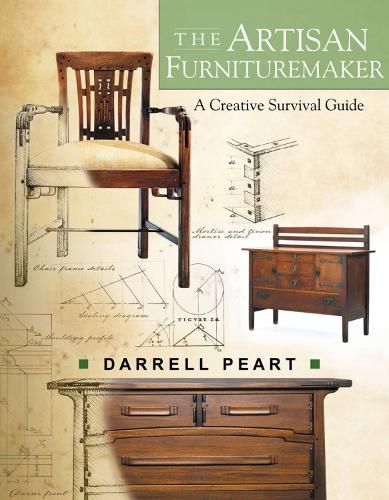Readings Newsletter
Become a Readings Member to make your shopping experience even easier.
Sign in or sign up for free!






Darrell Peart is a custom furnituremaker located in Seattle,
Washington. He is one of the leading authorities on Greene & Greene and lectures about design, woodworking and the history of the Greene brothers. He is the author of Greene & Greene: Design Elements for the Workshop and In the Greene & Greene Style. He has been in woodworking for over fifty years.
In his latest book Peart discusses the furnituremaker and what it takes to be successful in the field. He touches on The Makers Movement, the commitment to your craft, in this case furnituremaking,
and the acquisition of technical skill. However, the main thesis of the book is how to produce work that is original in nature. To produce adequate work is to follow the rules, obtain some technical skills, and work at your craft. To excel and create art that is infused with emotion and is original in nature, one has to have intuition and inspiration. This book is primarily a text on how to create and design. It is not a rule based book but rather an exploration of the methods the author has used during his long career to forge a very successful custom furniture business and produce art of lasting value.
draws upon William Varnum’s book, Industrial Arts Design. However, he stresses that this is just a starting point and that these equations and rules can not create originally inspired art. Intellect, intuition, and inspiration are all discussed in relation to art and craft. There is a thorough discussion of how Greene & Greene approached design and many examples are used to demonstrate their design brilliance. From there Peart moves on to demonstrate how you can enhance your own design and craftsmanship abilities by a process of what he calls Design DNA . Design DNA is a framework for asking the right questions and these questions may differ from person to person but the actual process is discussed at length. There is also a discussion on how to avoid the pitfalls of poor design.
$9.00 standard shipping within Australia
FREE standard shipping within Australia for orders over $100.00
Express & International shipping calculated at checkout
Darrell Peart is a custom furnituremaker located in Seattle,
Washington. He is one of the leading authorities on Greene & Greene and lectures about design, woodworking and the history of the Greene brothers. He is the author of Greene & Greene: Design Elements for the Workshop and In the Greene & Greene Style. He has been in woodworking for over fifty years.
In his latest book Peart discusses the furnituremaker and what it takes to be successful in the field. He touches on The Makers Movement, the commitment to your craft, in this case furnituremaking,
and the acquisition of technical skill. However, the main thesis of the book is how to produce work that is original in nature. To produce adequate work is to follow the rules, obtain some technical skills, and work at your craft. To excel and create art that is infused with emotion and is original in nature, one has to have intuition and inspiration. This book is primarily a text on how to create and design. It is not a rule based book but rather an exploration of the methods the author has used during his long career to forge a very successful custom furniture business and produce art of lasting value.
draws upon William Varnum’s book, Industrial Arts Design. However, he stresses that this is just a starting point and that these equations and rules can not create originally inspired art. Intellect, intuition, and inspiration are all discussed in relation to art and craft. There is a thorough discussion of how Greene & Greene approached design and many examples are used to demonstrate their design brilliance. From there Peart moves on to demonstrate how you can enhance your own design and craftsmanship abilities by a process of what he calls Design DNA . Design DNA is a framework for asking the right questions and these questions may differ from person to person but the actual process is discussed at length. There is also a discussion on how to avoid the pitfalls of poor design.